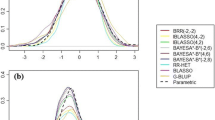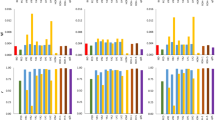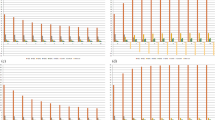Summary
A genetic model with either 64 or 1,600 unlinked biallelic loci and complete dominance was used to study prediction of additive and dominance effects in selected or unselected populations with inbreeding. For each locus the initial frequency of the favourable allele was 0.2, 0.5, or 0.8 in different alternatives, while the initial narrow-sense heritability was fixed at 0.30. A population of size 40 (20 males and 20 females) was simulated 1,000 times for five generations. In each generation 5 males and 10 or 20 females were mated, with each mating producing four or two offspring, respectively. Breeding individuals were selected randomly, on own phenotypic performance or such yielding increased inbreeding levels in subsequent generations. A statistical model containing individual additive and dominance effects but ignoring changes in mean and genetic covariances associated with dominance due to inbreeding resulted in significantly biased predictions of both effects in generations with inbreeding. Bias, assessed as the average difference between predicted and simulated genetic effects in each generation, increased almost linearly with the inbreeding coefficient. In a second statistical model the average effect of inbreeding on the mean was accounted for by a regression of phenotypic value on the inbreeding coefficient. The total dominance effect of an individual in that case was the sum of the average effect of inbreeding and an individual effect of dominance. Despite a high mean inbreeding coefficient (up to 0.35), predictions of additive and dominance effects obtained with this model were empirically unbiased for each initial frequency in the absence of selection and 64 unlinked loci. With phenotypic selection of 5 males and only 10 females in each generation and 64 loci, however, predictions of additive and dominance effects were significantly biased. Observed biases disappeared with 1,600 loci for allelic frequencies at 0.2 and 0.5. Bias was due to a considerable change in allelic frequency with phenotypic selection. Ignoring both the covariance between additive and dominance effects with inbreeding and the change in dominance variance due to inbreeding did not significantly bias prediction of additive and dominance effects in selected or unselected populations with inbreeding.
Similar content being viewed by others
References
Allaire FR, Henderson CR (1965) Specific combining abilities among dairy sires. J Dairy Sci 48:1096–1100
Bulmer MG (1980) The mathematical theory of quantitative genetics. Clarendon Press, Oxford
Crow JF, Kimura M (1970) An introduction to population genetics. Harper and Row, New York (1992)
DeStefano AL, Hoeschele I (1991) Utilization of dominance variance through mate allocation. J Dairy Sci (accepted)
Falconer DS (1989) Introduction to quantitative genetics. John Wiley & Sons, New York
Harris DL (1964) Genotypic covariances between inbred relatives. Genetics 50:1319–1348
Henderson CR (1975) Rapid method for computing the inverse of a relationship matrix. J Dairy Sci 58:1727–1730
Henderson CR (1985) Best linear unbiased prediction of nonadditive genetic merits in noninbred populations. J Anim Sci 60:111–117
Hoeschele I, Van Raden PM (1991) Rapid inversion of dominance relationship matrices for noninbred populations by including sire by dam subclass effects. J Dairy Sci 74:557–569
Jacquard A (1974) The genetic structure of populations. Springer, Berlin Heidelberg New York
Kempthorne O (1957) An introduction to genetic statistics. John Wiley & Sons, New York
Kennedy BW, Schaeffer LR, Sorensen DA (1988) Genetic properties of animal models. J Dairy Sci 71 [Supp12]:17–26
Mäki-Tanila A, Kennedy BW (1986) Mixed model methodology under genetic models with a small number of additive and non-additive loci. In: GE Dickerson, RJ Johnson (eds) Proc 3rd World Congr Genet Appl Livestock Prod, Vol 12. Lincoln, pp 443–448
Schaeffer LR, Kennedy BW (1986) Computing solutions to mixed model equations. In: GE Dickerson, RJ Johnson (eds) Proc 3rd World Congr Genet Appl Livestock Prod, Vol 12. Lincoln, pp 382–393
Smith SP, Mäki-Tanila A (1990) Genotypic covariance matrices and their inverses for models allowing dominance and inbreeding. Genet Sel Evol 22:65–91
Uimari P, Kennedy BW (1990) Mixed model methodology to estimate additive and dominance genetic values under complete dominance. In: WG Hill, R Thompson, JA Woolliams (eds) Proc 4th World Congr Genet Appl Livestock Prod, Vol 13. Edinburgh, pp 297–300
Van der Werf JHJ, De Boer IJM (1990) Estimation of additive genetic variance when base populations are selected. J Anim Sci 68:3124–3132
Author information
Authors and Affiliations
Additional information
Communicated by K. Sittman
Rights and permissions
About this article
Cite this article
de Boer, I.J.M., van Arendonk, J.A.M. Prediction of additive and dominance effects in selected or unselected populations with inbreeding. Theoret. Appl. Genetics 84, 451–459 (1992). https://doi.org/10.1007/BF00229506
Received:
Accepted:
Issue Date:
DOI: https://doi.org/10.1007/BF00229506




